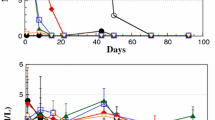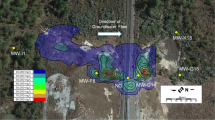Summary
Anaerobic microbial communities sampled from either a methanogenic or sulfate-reducing aquifer site have been tested for their ability to degrade a variety of groundwater pollutants, including halogenated aromatic compounds, simple alkyl phenols and tetrachloroethylene. The haloaromatic chemicals were biodegraded in methanogenic incubations but not under sulfate-reducing conditions. The primary degradative event was typically the reductive removal of the aryl halides. Complete dehalogenation of the aromatic moiety was required before substrate mineralization was observed. The lack of dehalogenation activity in sulfatereducing incubations was due, at least in part, to the high levels of sulfate rather than a lack of metabolic potential. In contrast, the degradation of cresol isomers occurred in both types of incubations but proved faster under sulfate-reducing conditions. The requisite microorganisms were enriched and the degradation pathway forp-cresol under the latter conditions involved the anaerobic oxidation of the aryl methyl group. Tetrachloroethylene was also degraded by reductive dehalogenation but under both incubation conditions. The initial conversion of this substrate to trichloroethylene was generally faster under methanogenic conditions. However, the transformation pathway slowed when dichloroethylene was produced and only trace concentrations of vinyl chloride were detected. These results illustrate that pollutant compounds can be biodegraded under anoxic conditions and a knowledge of the predominant ecological conditions is essential for accurate predictions of the transport and fate of such materials in aquifers.
Similar content being viewed by others
References
Abram, J.W. and D.B. Nedwell. 1978. Hydrogen as a substrate for methanogenesis and sulfate-reduction in anaerobic saltmarsh sediments. Arch. Microbiol. 117: 93–97.
Bak, F. and F. Widdel. 1986. Anaerobic degradation of phenol and phenol derivatives byDesulfobacterium phenolicum sp. nov. Arch. Microbiol. 146: 177–180.
Balch, W.E., S. Schoberth, R.S. Tanner and R. Wolfe. 1977.Acetobacterium, a new genus of hydrogen oxidizing carbon dioxide reducing, anaerobic bacterium. Int. J. Syst. Bacteriol. 27: 355–361.
Beeman, R.E. and J.M. Suffita. 1987. Microbial ecology of a shallow unconfined groundwater aquifer polluted by municipal landfill leachate. Microb. Ecol. 14: 39–54.
Borden, R.C. and P.B. Bedient. 1986. Transport of dissolved hydrocarbons influenced by reaeration and oxygen limited biodegradation. 1. Theoretical development. Water Resour. Res. 22: 1973–1983.
Bossert, I.D. and L.Y. Young. 1986. Anaerobic oxidation ofp-cresol by a denitrifying bacterium. Appl. Environ. Microbiol. 52: 1117–1122.
Bouwer, E.J. and P.L. McCarty. 1983. Transformations of 1- and 2-carbon halogenated aliphatic organic compounds under methanogenic conditions. Appl. Environ. Microbiol. 45: 1286–1294.
Bouwer, E.J., B.E. Rittman and P.L. McCarty. 1981. Anaerobic degradation of halogenated 1- and 2-carbon organic compounds. Environ. Sci. Technol. 15: 596–599.
Brant, M.P., E.A. Wolin, M.J. Wolin and R.S. Wolfe. 1967.Methanobacillus omelianskii, a symbiotic association of species of bacteria. Arch. Microbiol. 59: 20–31.
Cappenburg, T.E. 1974. Interaction between sulfate-reducing bacteria and methane-producing bacteria in bottom deposits of a freshwater lake. I. Field observation. Antonie van Leeuwenhoek 40: 285–295.
Ehrlich, G.G., D.F. Goerlitz, E.M. Godsy and M.F. Hult. 1982. Degradation of phenolic contaminants in groundwater by anaerobic bacteria: St. Louis Park, Minnesota. Ground Water 20: 703–710.
Fathepure, B.Z., J.P. Nengu and S.A. Boyd. 1987. Anaerobic bacteria that dechlorinate perchloroethene. Appl. Environ. Microbiol. 53: 2671–2674.
Fogel, M.M., A.R. Taddeo and S. Fogel. 1986. Biodegradation of chlorinated ethenes by a methane-utilizing mixed culture. Appl. Environ. Microbiol. 51: 720–724.
Fogel, S., R.L. Lancione and A.E. Sewall. 1982. Enhanced biodegradation of methoxychlor in soil under sequential environmental conditions. Appl. Environ. Microbiol. 44: 113–120.
Gibson, S.A. and J.M. Suflita. 1986. Extrapolation of biodegradation results to groundwater aquifers: reductive dehalogenation of aromatic compounds. Appl. Environ. Microbiol. 52: 681–688.
Godsy, E.M., D.F. Goerlitz and G.G. Ehrlich. 1983. Methanogenesis of phenolic compounds by a bacterial consortium from a contaminated aquifer in St. Louis Park, Minnesota. Bull. Environ. Contam. Toxicol. 30: 261–268.
Goerlitz, D.F., D.E. Troutman, E.M. Godsy and B.J. Franks. 1985. Migration of wood-preserving chemicals in contaminated groundwater in a sand aquifer at Pensacola, Florida. Environ. Sci. Technol. 19: 955–961.
Hopper, D.J. 1976. The hydroxylation ofp-cresol and its conversion top-hydroxybenzaldehyde inPseudomonas putida. Biochem. Biophys. Res. Commun. 69: 462–468.
Hopper, D.J. 1978. Incorporation of [18O]water in the formation ofp-hydroxybenzyl alcohol by thep-cresol methylhydroxylase fromPseudomonas putida. Biochem. J. 175: 345–347.
Humenick, J.J., L.N. Britton and C.F. Mattox. 1982. Natural restoration of groudwater in ECG. In Situ 6: 107–125.
Johnson, R.L., S.M. Brillante, L.M. Isabelle, J.E. Houck and J.F. Pankow. 1985. Migration of chlorophenolic compounds at the chemical waste disposal site at Alkali Lake, Oregon. II. Contaminant distributions, transport, and retardation. Ground Water 23: 652–666.
Kloepfer, R.D., D.M. Easley, B.B. Haas, Jr., T.G. Deihl, D.E. Jackson and C.J. Wurrey. 1985. Anaerobic degradation of trichloroethylene in soil. Environ. Sci. Technol. 19: 277–280.
Laanbroek, H.J. and N. Pfenning. 1981. Oxidation of shortchain fatty acids by sulfate-reducing bacteria in freshwater and in marine sediments. Arch. Microbiol. 128: 330–335.
McInerney, M.J., M. Byant and N. Pfennig. 1979. Anaerobic bacteria that degrade fatty acids in association with methanogens. Arch. Microbiol. 122: 129–135.
Nelson, M.J.K., S.O. Montgomery, W.R. Mahaffey and P.H. Pritchard. 1987. Biodegradation of trichloroethylene and involvement of an aromatic biodegradative pathway. Appl. Environ. Microbiol. 53: 949–954.
Oremland, R.S. and S. Polcin. 1982. Methanogenesis and sulfate reduction: competitive and noncompetitive substrates in estuary sediment. Appl. Environ. Microbiol. 44: 1270–1276.
Parsons, F., P.R. Wood and J. DeMarco. 1984. Transformation of tetrachloroethene and trichloroethene in microcosms and groundwater. J. Am. Water Works Assoc. 76: 56–59.
Reinhard, M., N.L. Goodman and J.F. Barker. 1984. Occurrence and distribution of organic chemicals in two landfill leachate plumes. Environ. Sci. Technol. 18: 953–961.
Robertson, J.M., C.R. Toussaint and M.A. Jorgue. 1974. Organic compounds entering groundwater from a landfill. Environmental Protection Technology Series Publication No. EPA 660/2-74-077, pp. 1–47, U.S. Environmental Protection Agency, Washington, DC.
Sawney, B.L. and R.P. Kozloski. 1984. Organic pollutants in leachates from landfill sites. J. Environ. Qual. 13: 349–352.
Senior, E. and M.T.M. Balba. 1984. The use of single-stage and multi-stage fermenters to study the metabolism of xenobiotic and naturally occurring molecules by interacting microbial associations. In: Microbiological Methods for Environmental Biotechnology (Grainger, J.M. and J.M. Lynch, eds.), pp. 275–293, Society for Applied Bacteriology, Academic Press, Inc., Orlando, FL.
Shelton, D.R. and J.M. Tiedje. 1984. Isolation and partial characterization of bacteria in an anaerobic consortium that mineralizes 3-chlorobenzoic acid. Appl. Environ. Microbiol. 48: 840–848.
Smith, R.L. and M.J. Klug. 1981. Electron donors utilized by sulfate-reducing bacteria in eutrophic lake sediments. Appl. Environ. Microbiol. 42: 116–121.
Smolenski, W.J. and J.M. Suflita. 1987. An HPLC system for the automatic sampling and analysis of time-series kinetic studies. J. Microbiol. Methods. 6: 71–79.
Smolenski, W.J. and J.M. Suflita. 1987. Biodegradation of cresol isomers in anoxic aquifers. Appl. Environ. Microbiol. 53: 710–716.
Staples, C.A., A.F. Werner and T.J. Hoogheem. 1985. Assessment of priority pollutant concentrations in the United States using STORET database. Environ. Toxicol. Chem. 4: 131–142.
Suflita, J.M., A. Horowitz, D.R. Shelton and J.M. Tiedje. 1982. Dehalogenation: a novel pathway for the anaerobic biodegradation of haloaromatic compounds. Science 218: 1115–1117.
Valo, R., V. Kitunen, M. Salkinoja-Salonen and S. Raisanen. 1984. Chlorinated phenols as contaminants of soil and water in the vicinity of two Finnish swamills. Chemosphere 13: 835–844.
Vogel, T.M. and P. McCarty. 1985. Biotransformation of tetrachloroethylene to trichloroethylene, dichloroethylene, vinyl chloride, and carbon dioxide under methanogenic conditions. Appl. Environ. Microbiol. 49: 1080–1083.
Westrick, J.J., J.W. Mello and R.F. Thomas. 1984. The groundwater supply survey. J. Am. Water Works Assoc. 76: 52–59.
Wilson, B.H., G.B. Smith and J.F. Rees. 1986. Biotransformations of selected alkylbenzenes and aliphatic hydrocarbons in methanogenic aquifer material: a microcosm study. Environ. Sci. Technol. 20: 997–1002.
Wilson, J.T. and B.H. Wilson. 1985. Biotransformation of trichloroethylene in soil. Appl. Environ. Microbiol. 49: 242–243.
Winfrey, M.R. and J.G. Zeikus. 1977. Effect of sulfate on carbon and electron flow during microbial methanogenesis in freshwater sediments. Appl. Environ. Microbiol. 33: 275–281.
Author information
Authors and Affiliations
Rights and permissions
About this article
Cite this article
Suflita, J.M., Gibson, S.A. & Beeman, R.E. Anaerobic biotransformations of pollutant chemicals in aquifers. Journal of Industrial Microbiology 3, 179–194 (1988). https://doi.org/10.1007/BF01569525
Received:
Revised:
Accepted:
Issue Date:
DOI: https://doi.org/10.1007/BF01569525




